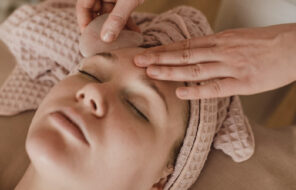*The author generated this text in part with ChatGPT, OpenAI’s GPT-3 large language model. The content was reviewed, edited, fact-checked, and revised by our editorial team.
If you’re the type of person who forgets to shave until right before you head out the door, it’s likely that you rush through the process or do a hurried dry shave over the sink. A quick and impulsive shave can leave you with itchy redness and aggravated bumps on your skin, perhaps even leading to the uneven skin tone of strawberry legs.
Whether you have sensitive skin or used your razor too aggressively, improper shaving can cause issues like razor burn. Razor burn will leave your skin irritated, itchy, and uncomfortable — a feeling nobody asked for.
We’ll tell you everything you need to know about what razor burn is and how to prevent it so you can walk out the door with soft, smooth legs every time.
What exactly is razor burn?
Razor burn is a common skin irritation that occurs after shaving. It can manifest as redness, itching, and rash-like bumps on the skin. In some cases, razor burn can also lead to ingrown hairs, which are hairs that curl around and grow back into the skin rather than protruding through the surface. Without a proper shaving routine, your skin can become prone to these uncomfortable byproducts of razor burn.
Razor burn causes and prevention tips
There are multiple causes of razor burn, ranging from the type of blade you use to how you approach shaving. Below are the common causes to be wary of:
- Dull razor blades. When a razor blade becomes dull, it can tug on the hair instead of cutting it cleanly, which can cause irritation and inflammation of the skin. To prevent razor burn, you’ll want to use a sharp, new blade and replace it frequently to avoid bacteria buildup and infection.
- Dry shaving. Dry skin is more prone to irritation and redness. Ensure your skin is hydrated by applying a moisturizer or shaving cream to the area before shaving. You can also try shaving after a shower or bath, as the warm water can help soften the hair.
- High-pressured shaving. Applying too much pressure when shaving furthers irritation and inflammation of the skin. To prevent this, use shaving cream to lubricate the skin and stroke the area lightly by letting the razor do the work.
- Sensitive skin. Highly sensitive skin is more likely to lead to razor burn. It’s best to use single-bladed razors to reduce the chances of irritation.
Additional prevention tactics
Pre-shave
Aside from regularly swapping out your razor for a fresh new blade and avoiding high-pressured dry shaving, you can try several other techniques to prevent razor burn. We recommend exfoliating the skin with a body scrub before shaving to remove any dead skin cells, which can clog up the razor and cause irritation. Gently exfoliating the skin can reduce the risk of ingrown hairs and promote healthy skin, too.
You’ll also want to apply shaving cream to smoothen the surface, reduce friction, and essentially minimize the risk of razor burn. Using a shaving cream that’s specifically formulated for sensitive skin is a great place to start.
During your shave
It’s best to shave in the direction of your hair growth and avoid multiple passes over the same area — and take your time while doing so. Rushing the process is never a good idea; it just increases the risk of nicks and cuts. Add it to your list of self-care activities to give yourself enough time to shave carefully rather than speeding through it three minutes before darting out the door.
Aftershave
As for your aftershave routine, avoid using alcohol-based products because they can dry out your skin and increase the risk of razor burn. Instead, use products that contain soothing ingredients like aloe vera or chamomile for a calming sensation. You can also take a cool shower or bath following your shave to soothe the skin further and reduce irritation. It can also be helpful to slather on a moisturizer formulated for sensitive skin to keep your skin hydrated post-shave.
Signs and symptoms
How do you know if you’re experiencing razor burn? The primary signs and symptoms to look out for include:
- Itching
- Redness
- Rash-like bumps
- Pain, discomfort, or sensitivity (to touch or pressure)
Some of these signs may not appear immediately after shaving, though. They can take a few hours to a couple of days to appear. Since razor burns can range from mild to severe, you’ll want to be cognizant of your skin and address any issues as soon as you notice them to avoid further irritation. If you experience severe pain or develop an infection, it’s best to see a doctor for proper treatment.
Essential soothing remedies
If you do develop razor burn, several remedies can help soothe the skin and mitigate redness and itching. One of the simplest remedies is to apply a cool compress to the area. The coolness can help reduce inflammation and discomfort. You can also try using an over-the-counter hydrocortisone cream or an aloe vera gel for a cooling and soothing effect.
As mentioned earlier, keeping the area moisturized is also essential, as dry skin can cause additional itching and irritation. A moisturizer that contains ingredients like shea butter, coconut oil, or glycerin can help to provide hydration.
Eliminate the burn
Following these tips and using the appropriate shaving techniques and products can reduce your risk of developing razor burns and promote healthy, flawless skin. A process that deals with sharp blades should only be on the top of your to-do list if you have enough time to dedicate to it. You know what they say: Slow and steady wins the race!





